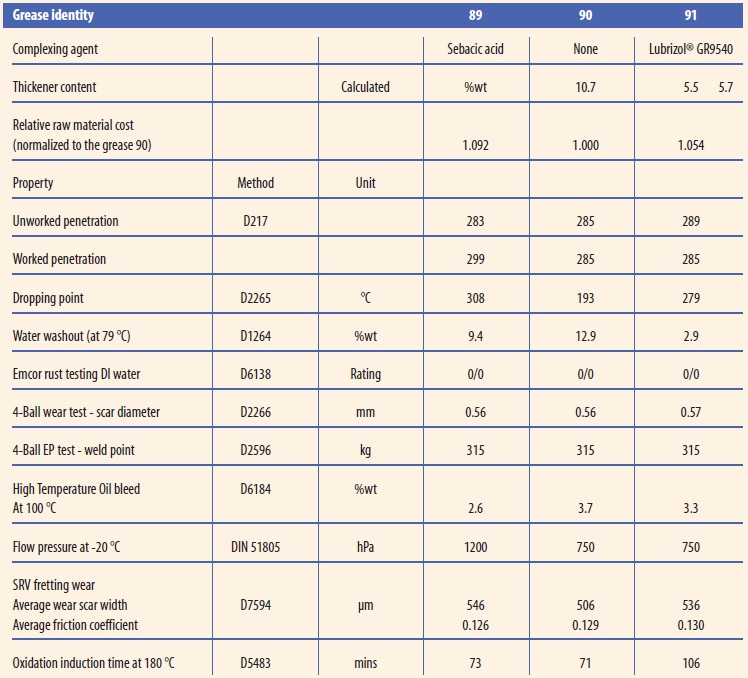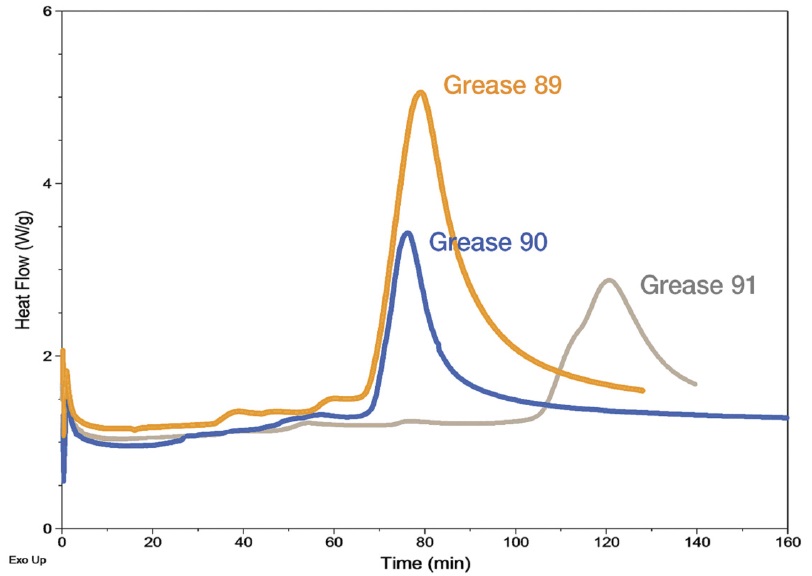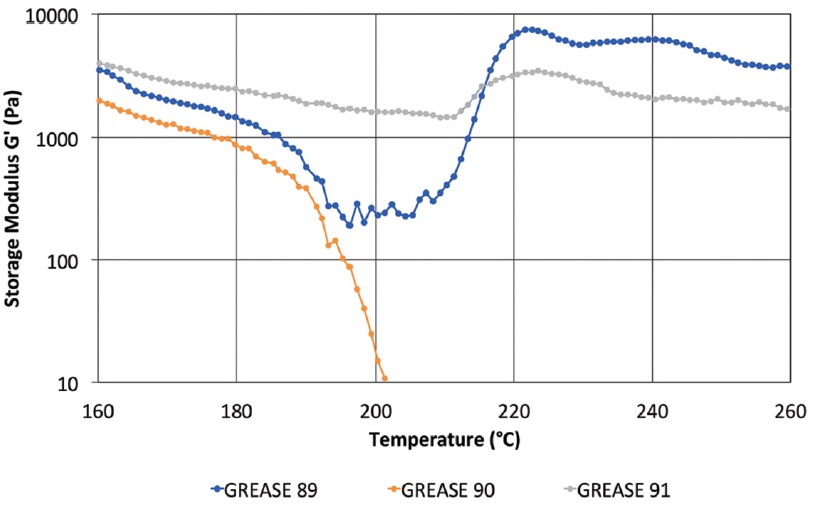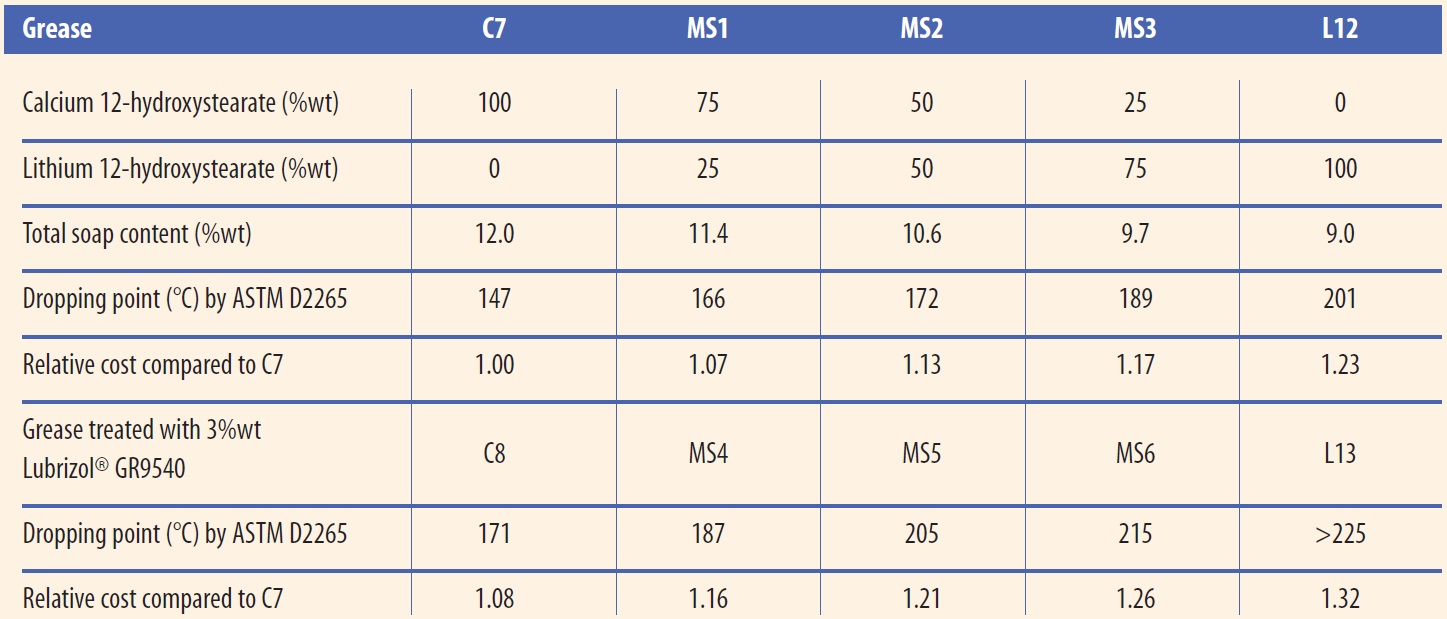The Lubrizol Corporation
Thickener Modifier Technology for High Performance Lubricating Greases – Lubrizol® GR9540
By Gareth Fish, PhD, CLS, CLGS, Technical Fellow, Chris Hsu, PhD, Senior Research Chemist, and Robert Dura, PhD, Technology Manager | TLT CMF Plus November 2017
Impact of Increased Demand for Lithium on Grease Thickeners
The market for lithium continues to grow with broad applications such as glass/ceramics, metallurgy, chemical synthesis, lubricants and, in particular, batteries. In the last 10 years, lithium ion batteries have risen in popularity to become the electrical power storage media of choice. The battery in a cell phone uses up to two grams of lithium, whilst a laptop computer or tablet uses four to eight grams of lithium (
1). The biggest new drivers of lithium demand are pure electric vehicles. It is estimated that a 70 kilowatt hours (kWh) battery to power a performance car would use 11,830 grams of lithium metal—the equivalent to 10,000 cell phones.
In 2015, global lithium demand was 35 kt. By 2025, global lithium demand is predicted to more than double, increasing to 76.2 kt. The volume anticipated in 2025 for batteries is 48.7 kt which is larger than the projected lithium supply volume that will be available (
1). Further, battery applications accounted for 36 %wt. of lithium demand in 2015; in 2025, lithium demand for battery applications is expected to grow to 65% of total lithium demand (
2). Additionally, the use of lithium metal in grease is projected to increase from 2,000 tons in 2015 to 4,400 tons in 2025. This additional demand for lithium for batteries will create supply and price pressure, requiring grease makers to look for alternatives to the thickener systems of greases that they manufacture.
Since 2005, the tonnage of lithium complex greases manufactured has doubled. Currently, the largest volume of grease thickeners sold globally is lithium soaps with around 74.2% of the market. Of that volume, 75% are simple soaps and 25% are lithium complexes (
3). In North America, lithium complex thickeners dominate, accounting for 39.1% of the market. Elsewhere, simple lithium soaps dominate with a market share of 53.3% in Europe, 56.4% in Japan, 85% in India, 63.6% in China and 53% in the rest of the world. A simple lithium grease based on 12-hydroxystearic acid uses about 1.2% weight of lithium hydroxide monohydrate (LHM) (0.20%wt of lithium metal) and a diacid carboxylate complex uses about 2.0% weight of LHM (0.33%wt of lithium metal).
Fortunately, thickener alternatives are available which reduce the negative impacts of cost and availability of lithium for grease manufacturers. We’ll look at multiple options and highlight new ways grease makers can use to deliver the same performance as lithium using Lubrizol® GR9540.
Thickener Modifier Technology for High Performance Lubricating Greases – Lubrizol® GR9540
Boric acid has been used as an alternative complexing agent for lithium greases for a number of years. As described in the NLGI grease Guide 6th Edition (
4), boric acid can be difficult to incorporate and is currently the subject of regulatory scrutiny. Incorporating other sources of boron into greases is now preferred. Borate esters, such as Lubrizol® 5370C, are still a relatively easy way to deliver higher heat resistance. Hydrolytic and thermal stability can be an issue with borate esters and they can release alcohols that can give rise to subjective undesirable alcoholic odours.
Lubrizol® GR9540 is a newly developed lower odor borate ester. It has been tested in a variety lithium greases to determine its effect on their heat stability and to explore its use as a grease complexing agent. The first data set used a simple lithium grease base with an ISO VG 100 group I mineral oil and compared Lubrizol® GR9540 to Lubrizol® 5370C, with and without the primary zinc dithiophosphate, Lubrizol® 1395.
The base greases were heated to 100 °C and the Lubrizol borate esters GR9540 and 5370C were mixed in, followed by the Lubrizol® 1395. The greases were milled and then de-aerated.
Table 1 shows that the new Lubrizol® GR9540 matched the behaviour of Lubrizol® 5370C. All complexed greases tested gave dropping points above 260 °C.
Table 1. The behaviour of borate ester additives in ISO VG 100 lithium grease

According to the NLGI grease Guide (
4), a complex soap thickener is one that contains a thickening soap and a complexing agent. The thickening soap solidifies the base oil and the complexing agent gives the thickening soap better temperature stability. It further states that the complexing agent used depends on the metal of the thickening soap. Calcium soaps are typically complexed with acetic acid and aluminium soaps are complexed with benzoic acid. The first complexing agent used for lithium soaps was acetic acid (
4) but this did not give the grease the same stability as it did for calcium greases. In the 1970s, boric acid was first used as a complexing agent. Dicarboxylic acids then became the complexing agents of choice and dropping points above 260 °C could be readily obtained. The common complexing diacids used are azelaic (C
9) and sebacic (C
10).
To evaluate the performance of Lubrizol® GR9540 as a complexing agent, three greases were manufactured, differing only in their complexing agent. All three used an ISO VG 220 blend of group I paraffinic oil, the 2000 Dalton polyisobutylene (PIB) Lubrizol® 3130 and the same multi-purpose zinc-containing additive package, Lubrizol® 5288, at 4% treat rate.
•
Sample 1: Grease 89, a 2:1 sebacate complex with a thickener content of 10.7%wt.
•
Sample 2: Grease 90, a simple lithium grease with 5.5%wt 12-hydroxystearate soap.
•
Sample 3: Grease 91, a 5.7%wt lithium 12-hydroxystearate soap complexed with 2%wt of the Lubrizol® GR9540.
A series of standard tests were carried out to compare the performance of these three greases and the results are reported in
Table 2.
Table 2. Comparison of lithium and lithium complex grease property data

The data gathered demonstrates that the Lubrizol® GR9540 lithium complex grease performed as well as the dicarboxylate lithium complex in higher temperature tests including rheology. Notable other results were the increase in oxidation life as measured using pressure differential scanning calorimetry (PDSC) and improved low temperature pumpability, comparable to the simple lithium grease. The PDSC behaviour of the three greases is shown in
Figure 1 and the rheological behaviour of the three greases is shown in
Figure 2.
 Figure 1. The PDSC behavior of the three greases
Figure 1. The PDSC behavior of the three greases
 Figure 2. Rheology plot comparison of the three greases
Figure 2. Rheology plot comparison of the three greases
By switching to a borate ester, such as Lubrizol® GR9540, for the complexing agent in a lithium soap, grease makers can save on the raw material costs for making a lithium complex grease, including the cost of the Lubrizol® GR9540.
Lubrizol® GR9540 Additive and Calcium Greases
Anhydrous calcium greases are a lower cost thickener option and are formed by the reaction of lime with 12-hydroxystearic acid. The heat resistance of this thickener type is lower than simple lithium soap thickened greases. When using the ASTM D2265 method, dropping point values of around 155 °C are obtained for anhydrous calcium greases. Several commodity grease specifications demand a dropping point above 177 °C (350 °F), which cannot be met by anhydrous calcium greases and so simple lithium soap greases are used. An investigation was conducted to see if Lubrizol® 5370C or Lubrizol® GR9540 borate ester chemistry could boost the dropping point of such anhydrous calcium greases, both with and without ZnDTP to above the 177 °C minimum. An NLGI #2 anhydrous calcium soap grease was prepared using an in situ reaction of hydrated lime mixed with water and 12-hydroxystearic acid in a 30:70 blend of a 750 naphthenic oil with a Group II 600N paraffinic.
Table 3 shows the data from the study of the two borates on the dropping point of anhydrous calcium greases. The dropping point of the grease was boosted but the 177 °C minimum value desired was not achieved.
Table 3. The behaviour of borate ester and zinc additives in anhydrous calcium grease
 Lubrizol® GR9540 Additive and Mixed Lithium-Calcium Soap Greases
Lubrizol® GR9540 Additive and Mixed Lithium-Calcium Soap Greases
To further investigate this, five new greases were manufactured in the same base oil blend as greases C1 through C6—a 30:70 blend of a 750 naphthenic oil with a Group II 600N paraffinic oil. The 12-hydroxystearic acid was heated in the oil and then the alkali lime or lithium hydroxide monohydrate or mixtures thereof mixed with water was added. The reaction mixture was held for saponification and then heated to 200 °C followed by cooling to 100 °C. The samples were then equally split into two portions. One half was treated with Lubrizol® GR9540 and the other was left as is. The resulting greases were milled and deaerated. The dropping points of all ten greases were then determined by ASTM D2265. The results of the study are in
Table 4.
Table 4. Mixed calcium-lithium soap greases treated with Lubrizol® GR9540

It is clear from the dropping point data that adding 3% of the Lubrizol® GR9540 to the 75% calcium: 25% lithium mixed soap grease (Grease MS10) gave a similar dropping point (187 °C) to that of the 25% calcium: 75% lithium (Grease MS9) without the Lubrizol® GR9540 present (189 °C). Both grease combinations gave higher dropping points than the required over 177 °C, showing that, by using the Lubrizol® GR9540, a lower amount of lithium grease is needed to pass this type of dropping point specification.
The relative raw material costs of all ten greases were then determined using typical market prices for hydrated lime, lithium hydroxide monohydrate, 12-hydroxystearic acid, and for the two base oils used. The costs were normalized to the cost of one kilogram of the anhydrous calcium soap thickened grease, C7 and are shown in
Table 4. At today’s cost of LHM, there is almost no cost difference between that of the MS9 grease and that of MS10. If the price of LHM keeps rising and its availability becomes less, as is anticipated, then the grease formulation MS10 using Lubrizol® GR9540 is more attractive as it enables the grease producer to overcome the current cost and supply issues with lithium hydroxide monohydrate and still produce greases with good heat stability.
References
(1)
http://www.dakotaminerals.com.au
(2)
Wietlisbach, S. and Glauser, J. IHS Chemical Economics Handbook Lithium, Lithium Minerals and Lithium Chemicals (746.5000), IHS Chemical, 2014
(3)
Grease Production Survey Report (For the calendar years 2015, 2014, 2013 and 2012), NLGI, Lee's Summit, Missouri 64063
(4)
NLGI Grease Guide, 6th Edition, 2015 NLGI, Lee's Summit, Missouri 64063 (
www.NLGI.org)